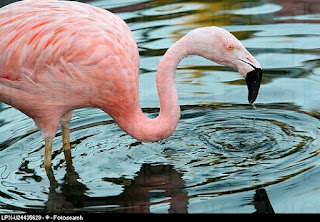Today, I heard quacking, but then I realized I
was just listening in the wrong language. Of late, I have been observing the
fowl world and more specifically communication, adaptation and behavioural
strategies.
I am particularly interested in the contrast between the flamingo and the brown duck because I find these feathered friends to be very familiar with our own species in the world of work and life.
2. Flamingos have balance and appreciate a little Zen, now and then.
3. Flamingos flourish famously and with fervour.
Flamingos have no
firm mating season. The parents build a mud-cone nest that holds one egg, which
males and females take turns incubating. When the chicks hatch, their parents
must take care to keep the infants from falling off the nest into the caustic
lake. When they are old enough to venture from the nest, chicks join groups of
thousands and explore their home lakes, waiting for their parents to bring them
mouthfuls of water at mealtimes. Flamingos hatch with grey plumage, but adults
range from light pink to bright red hue due to aqueous bacteria and beta
carotene obtained from their food supply.
4. Flamingos love to stand out, and show off. (Seriously, can you do this?)
My name is Lynn
Armstrong. I am such a pink flamingo, working in brown duck world. As a strategic planner and writer over the
past 16 years, I have worked with some of the brightest minds, helping them to
forge new directions and bringing those futures to life.
I am particularly interested in the contrast between the flamingo and the brown duck because I find these feathered friends to be very familiar with our own species in the world of work and life.
When one thinks of
the flamingo, we think of bright colors. The brown duck is often associated
with predictable (I did not say dull), guarded behaviour.
The flamingo is
thought to be gregarious, fabulous, fiery and flamboyant. The brown duck is
staid, serious, safe (dull?) in appearance.
The flamingo
celebrates and dances, while the brown duck perches and waddles. Flamingos like
to party in mobs (we have all seen the ever so popular lawn flamingos that
often converges in packs of 40 or 50) whereas brown decks tend to prefer the
linear approach to moving together.
Finally, flamingos are revered for their beauty; brown ducks make good decoys.
This column will explore how these two birds of a feather can work together through understanding and strategy.
Finally, flamingos are revered for their beauty; brown ducks make good decoys.
This column will explore how these two birds of a feather can work together through understanding and strategy.
To begin, here
some observations and facts about pink flamingos.
1. Flamingos have what it takes to survive a
caustic environment.
The flamingo is often referred to as "Fire
Birds" and are some of the only creatures designed to survive in the
caustic environment of a volcanic lake. Equipped with a filter-feeding system
unlike any other bird on earth, flamingos’ beaks have evolved to skim tiny
algae from the water's surface. By swinging their upside-down heads from side
to side or swishing water with their fat tongues, flamingos siphon the lake
water through their filters to trap algae. They can filter as many as
20 beakfuls of algae-rich water in a single second. This unique
feeding system gives flamingos a certain security and competitive edge. While
they must watch out for predators like jackals or eagles, they compete with no
other animals for food.
2. Flamingos have balance and appreciate a little Zen, now and then.
Flamingos often stand on one leg, the other tucked beneath the body. The
reason for this behaviour is not fully understood. Some suggest that the
flamingo, like some other animals, has the ability to have half of its body go
into a state of sleep, and when one side is rested, the flamingo will switch
legs and then let the other half sleep, but this has not been proven. Recent
research has indicated that standing on one leg may allow the birds to conserve
more body heat, given they spend a significant amount of time wading in cold
water.
3. Flamingos flourish famously and with fervour.
4. Flamingos love to stand out, and show off. (Seriously, can you do this?)
A well-fed, healthy flamingo is more vibrantly coloured and thus a more
desirable mate. A white or pale flamingo, however, is usually unhealthy or
malnourished. Captive flamingos are a notable exception; many turn a pale pink
as they are not fed carotene at levels comparable to the wild.
5. Flamingos love to flash mob dance.
5. Flamingos love to flash mob dance.
Posturing and signalling
with their wings, bowing and bending their necks, running back and forth as a
group, and then suddenly taking flight to wheel around the edges of the lake --
a crowd of dancing flamingos is one of the strangest, most breathtaking sights
in the natural world. Is it a mating ritual? Are the birds burning up excess
energy? Or do they do it simply for fun? No one is really sure.
Click on the link here to see Flamingos flash mob dance: http://www.boreme.com/boreme/funny-2008/flamingo-mating-dance-p1.php
Click on the link here to see Flamingos flash mob dance: http://www.boreme.com/boreme/funny-2008/flamingo-mating-dance-p1.php
Sources: http://www.pbs.org/wnet/nature/firebird/html/facts.html)





Comments
Post a Comment
Thank you for taking the time to read my blog. I would love to hear your comments. Thanks and have an awesome day. - Lynn